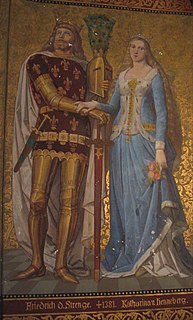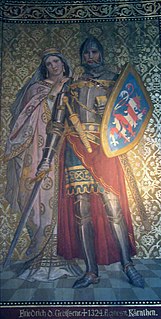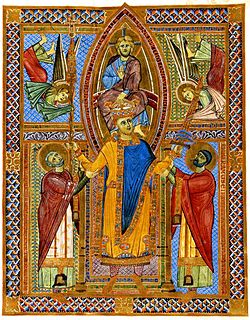Related Research Articles

Year 1024 (MXXIV) was a leap year starting on Wednesday of the Julian calendar.
Bolesław the Brave, less often known as Bolesław the Great, was Duke of Poland from 992 to 1025, and the first King of Poland in 1025. He was also Duke of Bohemia between 1002 and 1003. He was the son of Mieszko I of Poland by his wife, Dobrawa of Bohemia. According to a scholarly theory, Bolesław ruled Lesser Poland already during the last years of his father's reign. Mieszko I, who died in 992, divided Poland among his sons, but Bolesław expelled his father's last wife, Oda of Haldensleben, and his half-brothers and reunited Poland between 992 and 995.

Conrad II, also known as Conrad the Elder and Conrad the Salic, was Emperor of the Holy Roman Empire from 1027 until his death in 1039. The first of a succession of four Salian emperors, who reigned for one century until 1125, Conrad also served as King of Germany from 1024, King of Italy from 1026, and King of Burgundy (Arelat) from 1033.

Henry II, called the Wrangler or the Quarrelsome, a member of the German royal Ottonian dynasty, was Duke of Bavaria from 955 to 976 and again from 985 to 995, as well as Duke of Carinthia from 989 to 995.

Ernest was Elector of Saxony from 1464 to 1486.
Odilo, also Oatilo or Uatilo of the Agilolfing dynasty was Duke of Bavaria from 736 until his death. He had the Lex Baiuvariorum compilation edited, the first ancient Germanic law collection of the Bavarians.

Frederick II, The Gentle was Elector of Saxony (1428–1464) and was Landgrave of Thuringia (1440–1445).

Frederick III, the Strict, Landgrave of Thuringia and Margrave of Meissen, was the son of Frederick II, Margrave of Meissen and Mathilde of Bavaria.

Frederick II, the Serious, Margrave of Meissen, son of Frederick I, Margrave of Meissen and Elisabeth von Lobdeburg-Arnshaugk.

Frederick I, called the Brave or the Bitten was Margrave of Meissen and Landgrave of Thuringia.
The Brunonids were a Saxon noble family in the 10th and 11th centuries, who owned property in Eastphalia and Frisia.
Hugbert(also Hukbert) of the Agilolfings was duke of Bavaria from 725 to 736. He was son of the duke Theudebert and Regintrud, the probable daughter of the Seneschal Hugobert and Irmina of Oeren.
Regintrud, also known as Reginlind and Regentrud, probably was the wife of Duke Theodbert of Bavaria or of his father Duke Theodo of Bavaria. A possibly identical Regintrud became abbess of Nonnberg Abbey in 720–725. However, details about her ancestry and life are widely disputed among historians.
Theodbert was the duke of Bavaria in some capacity or other from 702 to his death. He was the eldest son of Duke Theodo of Bavaria and Folchaid. He was first associated with his father as duke in 702, ruling from Salzburg. In 711, his younger brother Theobald was co-ruling as well and his father was making plans for a fourfold division of the duchy on his death. Sometime before 715, the division was given, but whether territorial or coregent is not known. If the former, the dioceses set up by Theodo probably corresponded to the duchies of his sons. In that scenario, Theodbert probably had his seat at Salzburg, as since 702.

Princess Elisabeth Helene of Thurn and Taxis was a Princess of Thurn und Taxis by birth and a Princess and Duchess of Saxony, Margravine of Meissen, and titular Queen consort of Saxony through her marriage to Friedrich Christian, Margrave of Meissen. Elisabeth was the sixth child of Albert, 8th Prince of Thurn and Taxis and his wife Archduchess Margarethe Klementine of Austria.

Matilde of Bavaria Meißen) was the eldest daughter of Louis IV, Holy Roman Emperor and his first wife Beatrix of Świdnica. Matilde was a member of the House of Wittelsbach.

Henry II, also known as Saint Henry the Exuberant, Obl. S. B., was Holy Roman Emperor from 1014. He died without an heir in 1024, and was the last ruler of the Ottonian line. As Duke of Bavaria, appointed in 995, Henry became King of the Romans following the sudden death of his second cousin, Emperor Otto III in 1002, was made King of Italy in 1004, and crowned emperor by Pope Benedict VIII in 1014.
The German–Polish War which took place from 1002 to 1018 consisted of a series of struggles between the Ottonian king Henry II of Germany and the Polish Piast ruler Bolesław I the Brave. The locus of conflict was the control of Lusatia, Upper Lusatia, as well as Bohemia, Moravia and Slovakia. The fighting ended with the Peace of Bautzen in 1018, which left Lusatia and Upper Lusatia as a fief to Poland, and Bohemia became a duchy in the Holy Roman Empire.

William I, the one-eyed, was Margrave of Meissen. His surname is related to the legend that Saint Benno appeared to him because of his disputes with the Church in a dream and he had an eye gouged out.
Henry II may refer to:
References
- ↑ Sächsische Biografie
- 1 2 Eduard Machatschek: Geschichte der Bischöfe des Hochstiftes Meissen in chronologischer Reihenfolge &c (pp. 38-43). Dresden 1884
| Preceded by Eilward | Bishop of Meissen 1016–1023 | Succeeded by Dietrich I of Meissen |
| This article about a German Catholic bishop or archbishop is a stub. You can help Wikipedia by expanding it. |